I thought that I would share what I have learned during my years as a ganja farmer so I put together this guide.
Most of these points relate to growing in soil indoors. I’ll leave the tips on how to grow hydroponically to the experts. Most of the information in this text is based on personal experience and common belief. I have gathered this information by growing indoors and outdoors, both indicas and sativas. There are many effective ways of growing weed and the guidelines presented here are either of a general nature or directly related to my own style of growing. I have tried to cover as much as possible in order to give you a clear picture of what you can expect. Keep in mind that some of the things explained in this guide might be simplified for practical reasons and that there might also be different theories on how the plant works which are not covered here.
All the underlined text in this guide contain links, so you might want to check them out.
Most of these points relate to growing in soil indoors. I’ll leave the tips on how to grow hydroponically to the experts. Most of the information in this text is based on personal experience and common belief. I have gathered this information by growing indoors and outdoors, both indicas and sativas. There are many effective ways of growing weed and the guidelines presented here are either of a general nature or directly related to my own style of growing. I have tried to cover as much as possible in order to give you a clear picture of what you can expect. Keep in mind that some of the things explained in this guide might be simplified for practical reasons and that there might also be different theories on how the plant works which are not covered here.
All the underlined text in this guide contain links, so you might want to check them out.
Herb is for the use of Man
It comes from the earth. Cannabis plants have a wide variety of uses, ranging from its psychoactive and medicinal properties to fiber hemp used to make fabric, fuel and building material.
All and all it is a very versatile plant.
Cannabis has been grown for a very long time. The oldest stash of seeds and bud ever found was 2,700 years old and was discovered on two mummies in China. The research team could not get the seeds to germinate and the THC in the bud was long gone but this proves that we have a long history of cultivating cannabis.
The very fact that we have receptors in our brains which sole purpose is to bind cannabinoids, proves a strong point for the recreational, spiritual and medicinal use of cannabis.
This guide contains information on how to grow, flower and harvest your crops, what equipment you will need and how to setup your grow room.
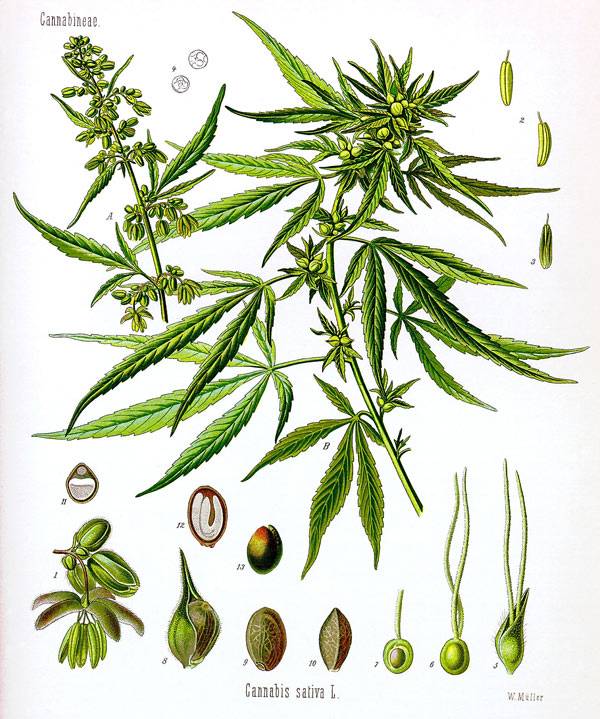
All and all it is a very versatile plant.
Cannabis has been grown for a very long time. The oldest stash of seeds and bud ever found was 2,700 years old and was discovered on two mummies in China. The research team could not get the seeds to germinate and the THC in the bud was long gone but this proves that we have a long history of cultivating cannabis.
The very fact that we have receptors in our brains which sole purpose is to bind cannabinoids, proves a strong point for the recreational, spiritual and medicinal use of cannabis.
This guide contains information on how to grow, flower and harvest your crops, what equipment you will need and how to setup your grow room.
Indica / Sativa / Ruderalis
Cannabis Sativa is a dioecious (distinctly male or female), equatorial plant, that originates from tropical regions of the world. The seedless female flower or "Sensimilla" is what we are after when we grow these plants. Different species and strains of cannabis flower under different conditions depending on their place of origin. In theory we can divide the cannabis plant into three different subspecies; Sativa, Indica and Ruderalis.
In order to induce flowering in the cannabis plant indoors, we have to manipulate the hours of light that the plant receives each day. Most cannabis plants will remain in a vegetative state until the day becomes as long as the night, in other words, until we put them under a 12/12, lights on/off schedule.
It is also during this time that the plants will reveal their sex.
Sativa plants are usually found in tropical areas of the world, close to the equator, where the length of day and night is about the same all year round. It is therefore perfectly acceptable to grow tropical sativas under a light regime of 13/11 during vegetative growth and to flower them under 11/13 on/off. Sometimes sativas won’t even flower under 12/12 as it is so close to “home” that they just keep on growing. Sativas take longer to finish flowering than indicas, usually twice as long and sometimes even three times as long. Sativas are generally more tall and lanky than their indica counterparts. They have thin and modestly serrated leafs like in the picture above. Indica leafs on the other hand can be very wide and heavily serrated. Both species can have very large leafs, sometimes several times larger than your hand.
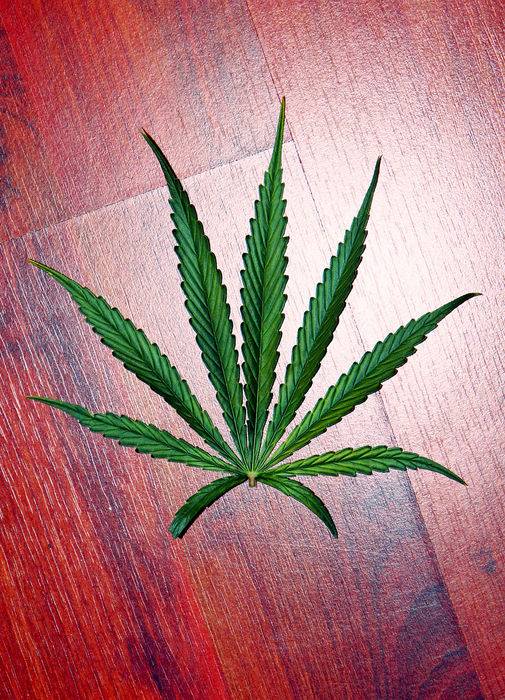
The sativa buds are also different in appearance and structure to the indica buds. Sativa buds sometimes resemble a fox-tail and are not as tightly packed as indica buds. Getting tight sativa buds really is an art form that requires some practice.
The Cannabis Indica subspecies on the other hand, has adapted to the colder climates and shorter days further up north from the equator. Some sources actually identify the Indica subspecies as the first cannabis plants and theorize that the plant adapted to the tropics. They place the birth of cannabis somewhere in the Hindu Kush mountain regions, that span across Afghanistan, Pakistan and India. Most indica plants will remain in a vegetative state until the light regime is changed to 12/12, with some variation between strains. Some early maturing indica strains will flower under 18/6, lights on/off. Indicas have thicker and broader, more prominently serrated leafs than their sativa counter parts and the buds are usually more compact, sometimes even rock hard. They stay shorter and grow wider than sativas, often branching out heavily with frequent nodes (bud sites).
Sativa plants pack a more racy, cerebral and creative high compared the sedating, body stone effect that you get from smoking indica plants. The high can be very strong in both cases although the experience might be different. Some growers prefer the cerebral high but it can sometimes make you a bit paranoid and raise your pulse, so others prefer to get stoned because the experience is more gentle on the mind.
The third subspecies is Cannabis Ruderalis which originates from sativa plants that escaped from outdoor plantations in northern Russia and other parts of Eastern Europe. Because the day can be very long during parts of the year in these areas, reaching up to 24/0 in the summertime, the plants developed the unusual ability to flower under any light conditions.
Some commercial strains like Lowryder carry Ruderalis genes which means that they can be grown outdoors in arctic regions of the world since they will flower regardless of the photoperiod. They are also a valid choice for indoor grows where height is an issue, because these plants are cannabis dwarfs and only grow so big. There are mixed opinions regarding these auto-flowering plants but personally I find them to be an interesting addition to the spectrum of cannabis strains that are commercially available today.
It is more difficult to grow sativas because of the way they behave but once you learn how to grow them properly, growing indicas becomes a breeze. Indicas have a more predictable growth pattern, they can be kept quite low and do not stretch as much as sativas. The closer you get to a pure sativa, the more trouble you are looking at. Sativa plants also seem to have less distinction between the vegetative and flowering stage compared to indica plants, which means that they might continue growing in height even when the light schedule is reduced to 12/12. This also means that they are more difficult to control in the indoor environment. Often a good 50/50 mix will have the best of both worlds in terms of easiness and potency.
Equipment and Hardware
It is generally known that plants prefer light from the blue spectrum (6400K) during vegetative growth and light from the yellow/red spectrum (2700K) during flowering. Sources of blue light are compact fluoros and metal halide gas discharge bulbs. High pressure sodium is currently the best solution for the flowering spectrum although there are also more advanced solutions, like the Ceramic Metal Halides or CMH. The CMH's put out less heat but only come in smaller sizes, so the HPS might still be your best solution. The gas discharge bulbs must be connected to a ballast in order to operate.
Naturally you will also need to put your light on a timer as pulling the plug every day during flowering is not a very practical solution. Make sure that the timer can handle more watts than your ballast puts out. The output of gas discharge bulbs range anywhere from 35 watts to 1000 watts, where the 600 watt lights are the best bang for buck because they put out twice the amount of light of the 400 watt light at a low cost of 200 watts. The step upwards to 1000 watts is not as cost efficient but more light is always better so many people use them nonetheless.
The gas discharge bulbs will always outperform the compact fluoros, although they also do a pretty good job at close range. The benefit here is that compact fluoros emit almost no heat so there is no need for noisy fans etc, which means that your setup is basically running silent. I have tried both and can honestly say that nothing beats MH and HPS in terms of plant vigor and health as well as bud development and crop size.
What is generally not known is that there are photosynthetic pigments in plants relating to each spectrum of light, chlorophyll a (red) and chlorophyll b (blue) respectively. The plant is capable of producing more or less of each pigment in its fan leafs, depending on what sort of light is available. That said, plants still grow stronger under the corresponding light for each stage of development but also benefit from receiving both during their whole lifespan as both pigments are active to some degree outside their optimal wavelength. The perfect setup would include 2:1 metal halide sources during the vegetative stage and 2:1 high pressure sodium sources during flowering. Since few growers can afford a setup like this, you might have to compromise. A good solution are enhanced spectrum HPS bulbs that emit a little blue light as well as the red light, like the Eye Hortilux or the Osram Plantastar for example, which I personally use during flowering with great results. You can both veg and flower the plants under HPS lights but MH lights are mostly good for the vegetative stage, although they improve on the quality of the finished product when used during flowering alongside the HPS.
Always try to get the light as close to the plants as you can without burning them. The distance is good if you can keep your hand in place above the canopy for a longer period of time without any discomfort. It is good to remember however that both HPS and MH bulbs put out a fair deal of infrared radiation and the heat from the light can cause harm to the plant.
Here are reference charts for both MH and HPS lights that might help you decide how close you will keep them to the canopy. Thanks to CaliGrower for putting them together.
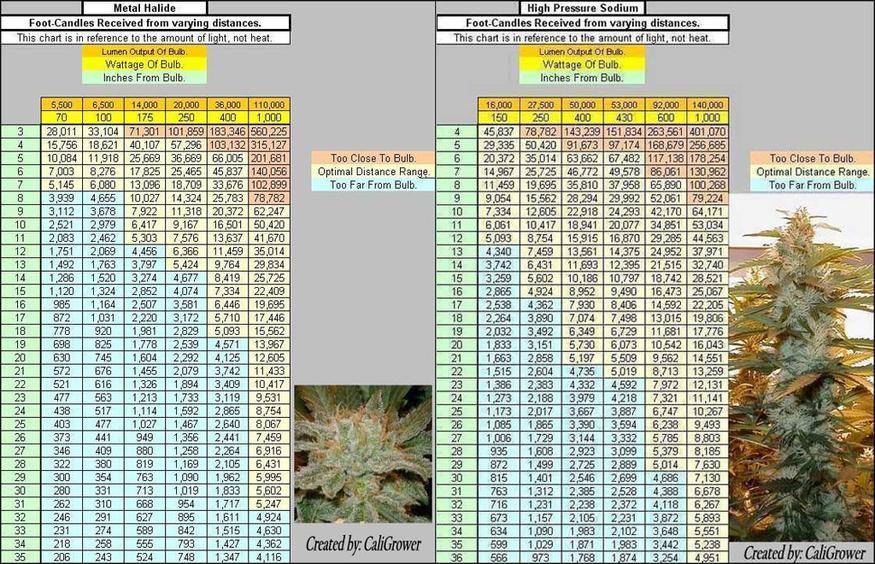
Those used to the metric system must use a converter to get the right distance.
Those used to the metric system must use a converter to get the right distance.
It is advisable to change the gas discharge bulb (MH and HPS) every other harvest or at least after four harvests, depending on the bulb. You can find the specifications for your bulb on the manufacturer's website but generally HPS and MH lamps should be good for 10,000 hours of constant use.
Here is an example of how you can hook up your equipment. In this case I had to fit a lot of hardware into a closet and have since updated the setup but at least you get an idea of what I am talking about. You can use this picture as reference and scale your setup according to your needs. You might want to start out with something smaller and more simple but if you feel up to it, but I would never discourage anyone from putting together the best possible setup. You can get the necessary hardware first and later upgrade when you need something new. That's what I did.
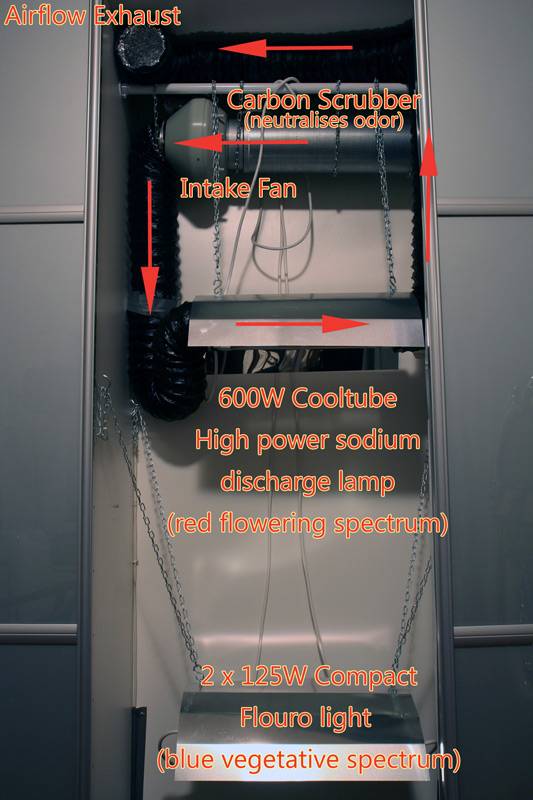
Nothing is more important than stealth so make sure that you have some kind of odor control, either a carbon scrubber or an ionizer. The benefit of using a carbon scrubber is that you can hook the fan (and scrubber) to a cool tube or air-cooled hood, thereby killing two birds with one stone by allowing the fan to both neutralize odor and cool the hot HPS or MH bulb. You can have the fan sucking or blowing air through the filter, both methods work but the filters are not designed to have air blown out through them so my recommendation is that you use them as they were intended. A high-performance fan, like say an industrial duct fan will also ensure that the grow room gets proper air exchange. This means that a lot of free CO2 will stream to the grow room and keep your plants healthy. I like to keep my setup as silent as possible, which means that I have noise-insulated ducting etc.
Personally I prefer the air-cooled hood as cool tubes tend to create “hotspots” which basically means that the rounded glass of the cool tube works as a magnifying glass, burning the plants directly underneath it. Hoods also do a better job at dispersing the reflected light over a greater area as cool tubes usually come with a small reflector. If the light is dispersed over a greater area the ambient temperature also drops in the grow room and the plants receive more light.
In terms of reflective efficiency, solid white surfaces do the best job reflecting upwards of 90% of the light emitted by your bulb. Second comes mylar with something close to those percentages. Avoid using mirrors in the grow room as they in fact absorb more light than they reflect.
A great addition to your setup is a humidifier or mister. This will ensure that you have a high relative humidity in your grow room during the vegetative stage. Since plants can also be foliar fed by spraying the leafs, they will be very happy with the constant supply of humidity and remain nicely green and healthy. One could even add nutrients to the mister if one wanted but I rather keep the machine clean and foliar feed manually.
Another good addition to the grow room are fans. Not only do they keep the plants cool and distribute Co2 around the grow room, they also make the stems grow thicker due to the rocking, wind-effect found in nature. Fans can however be quite noisy so it is up to you to decide if you want them in the grow room. Also make sure that the fans are not touching the walls or you might get resonance which can draw unwanted attention to your grow room. If you do not use fans you will have to provide other means of support for the plants during flowering because the buds might get so heavy that the branches cannot support them throughout flowering.
--------------------------------------------------------------------------------------------------------------------------------------
The absolutely, positively most important thing to remember is that you have to make your grow room entirely light proof. If you can see your own hand at close range it is not dark enough. It really has to be pitch-black in the grow room during the dark hours or the plants will not flower properly and might even become hermaphrodites. You have to remember that in nature when the sun goes down, there is absolutely no light present besides moon light, which is so low in strength that some have speculated that even the light from a candle, placed on the other side of a room, is enough to confuse the plants. This is something that you really have to get right in order to successfully flower your cannabis plants.
--------------------------------------------------------------------------------------------------------------------------------------
General Growing Information
It is always a good idea to mix fertilizers into the soil no matter what form of fertilization one intends to use. This will keep the plants healthy and they will also have something to fall back on in case they need to. Since plants need mostly Nitrogen (N) during the vegetative stage and Phosphorus (P) during flowering, a mix of say guano and bone meal with some blood meal will ensure that the plant has what it needs. The plant also needs a variety of other micro nutrients and trace metals in order to grow to its full potential so the best advice that I can give is that you try to provide the best environment possible for your plants. The fact that plants need water in order to survive goes without saying. The nutrients that are in the picture above are just an example of what you could use. There are many different ways to go and even the regular plant nutrients that you can find in your local shop will work.
Fan leafs (the big ones) are used both as solar panels and for storing energy. This is where most of the photosynthetic process takes place and where the bulk of the energy is stored. There are mixed opinions whether or not to trim fan leafs but in general you should leave them be even if you are tempted to remove them. I sometimes remove the smaller leafs on the branches but leave the big ones alone for most of the time. The plant will decide whether or not the leaf is needed and relocates the energy stored in it if needed. The argument for removing them has been that they might prevent light from reaching buds sites in flowering but the counter argument would be that light does pass through the leafs although we cannot observe this with the naked eye. You decide, a third option would be to split the fan leafs in half allowing more light to pass through. They can also be tucked or tied down, allowing more light to pass further down the canopy without actually removing any growth.
Remember that it is possible to feed your plants too much and cause nutrient burn and other problems. By doing so you may also create micronutrient lockouts which will resemble under or over-fertilization and salt build-up in the soil that can severely damage your plant. By feeding the plant more at this stage you actually make things even worse. If you notice these symptoms, flush the plant with plenty of water and look up a nutrient disorder guide.
Here are some diagrams explaining the most common problems:
Nitrogen - Phosphorus - Potassium - Magnesium - Iron & Sulphur - Zinc & Manganese - Toxic Salts Buildup
Nitrogen - Phosphorus - Potassium - Magnesium - Iron & Sulphur - Zinc & Manganese - Toxic Salts Buildup
I will not go into this here because there are a lot of good posts by educated experts on this forum regarding nutrient disorders.
Nothing beats organic fertilizers when it comes to how they affect the scent and taste of buds in my opinion. Chemical fertilizers are very strong and more difficult for the plant to break down. Great results can be achieved with both but the organic way resembles more the conditions in nature. Organic fertilizers include compost, organic material like seaweed, ash, bone meal, blood meal, guano etc.. etc.. It is also easier to cause nutrient burn with synthetic fertilizers. If you use chemical fertilizers make sure that you flush your plants for at least two weeks prior to harvest or they might affect the taste. Plants that are grown with chemical fertilizers, that have not been flushed properly prior to harvest, can actually contain so much nutrients that they burn your lips when you smoke the weed.
By flushing I mean that you stop feeding the plants nutrients and only supply ph adjusted water. It is generally a good idea to flush your plants regardless of what means of fertilization you chose, although it is not necessary when growing organically. The plants will draw energy from its leafs and direct it into the flowers. At this stage the chlorophyll is drawn from the leafs, revealing the underlying colors of the carotenoids, micronutrients and trace metals. The plant might display an array of beautiful colors ranging from deep purple to orange and red.
Keep in mind that you can also foliar feed your plants by spraying the top and especially the underside of the leafs with a weak nutrient solution. Plants love this.
Always make sure that the pots you use have holes in the bottom to allow the excess water to drain off. If you have solid pots water will gather at the bottom and eventually go sour, causing problems with ph and possibly root rot. Plants do not like “wet feet”. Also remember that you need to add something to the soil to keep it from packing together and essentially turning into mud. There are various products that fill this description, all of which can be found at most gardening stores.
A large pot is always better than a small one. More space equals more root mass which in turn equals bigger plants.
In the end it’s all about roots. Good soil goes a long way.
You can always repot your plants once they gain size but generally it's better to start them in the pot that they will use throughout their entire lifecycle. Sometimes it is more practical to start them in smaller pots, say if you start more plants from seeds than you will have room for. Then you need to sex your plants and as soon as you find the females, repot them into a pot of decent size. It all depends on how much room you have but generally a 10L or 2.6 gallon pot will do. I use slightly smaller pots so that I will have room for more plants. Pot size also determines the final size of the plant so if you want them to stay a bit smaller, use smaller pots.
Cannabis plant can handle a wide range of environmental fluctuations but a temperature of 25-27 degrees Celsius or 77 to 81 degrees Fahrenheit is generally considered the optimal. Your plants can handle lower and higher temperatures but once you get to the extremes your plants will suffer from stress related symptoms, so try your best to keep it inside the good range. When the temperature gets really cold, photosynthesis stops and the plant goes into hibernation. If the temperature drop to freezing the plant gets frostbite and severe tissue damage as water is essentially it’s blood. Too high temperatures will also harm your plants, a good rule of thumb is that the ambient temperature should be pleasant, like a warm day at the beach say.
A ph of 6-7 is considered optimum, which can easily be regulated with ph up or down solutions. You can get a successful grow by mixing nutrients into the soil and then just let the plants extract what they need throughout the grow, but if you intend to feed the plants liquid nutrients in order to improve on taste and scent you will need a couple of things. In order to adjust the ph of your nutrient mix you will need some PH+ and PH- solutions and a pipette. You will also need some means of measuring the ph. There are a few alternatives, one being litmus paper, another a drop tester, or if you want to go high-tech get an electronic meter. They are however quite expensive and you won't really need to be that precise unless you growing hydroponically. If that is the case you will also need an EC meter that measures the electro conductivity or salt concentration of your nutrient solution. Soil is more forgiving due to the slow uptake of nutrients so you get away with more flux.
There are several more things that affect the health of the plant, like the hardness and calcium content of your tap water etc. etc. Just make sure that you provide the best environment that you can for your plants.
The rate of photosynthesis is directly related to the availability of CO2 so talk to your plants!
Some grower who want to give their plants the best possible environment will rig up bottled CO2 with a slow-release valve and use air conditioning to keep the temperature in the grow room at optimal levels. Anything is possible.
The rate of photosynthesis is directly related to the availability of CO2 so talk to your plants!
Some grower who want to give their plants the best possible environment will rig up bottled CO2 with a slow-release valve and use air conditioning to keep the temperature in the grow room at optimal levels. Anything is possible.
Seed Germination
There are several ways of germinating seeds, where the most common is to place the seeds between a few sheets of wet paper towel. This is probably the best method but seeds will also germinate when planted directly into soil.
After placing the seeds between the paper towels, put them in a box and keep the paper towels wet at all times. Seeds will usually germinate in 1-7 days. If it takes much longer than that, you might have to assume that the seeds are dead or that they need some help. Applying some heat underneath the box (like placing it on the heating element/radiator) will effectively turn the box into an incubator and the seeds will germinate faster. Once the taproot has cracked the seed and emerged, it ready to be planted into soil.
What emerges from the seed is the tap root so it should therefore be planted so that it points down towards the earth. The green, or top part of the plant, which eventually emerges from the seed, is guided by light (Phototropism). The roots navigate in response to gravity (Gravitropism). Roots towards the earth and leafs towards the sky.
Sometimes you will run into tough or old seeds that fail to crack the shell. There are a few ways of getting them to germinate. If your seeds to not germinate normally within a week, I recommend that you try one of these methods.
Method 1:
Take a really sharp knife, a scalpel or maybe a carpet knife will do. Something really sharp anyway, the smaller the blade the better as this is precision work. Hold the seed between your fingers and chip the outer shell /seed coat at the top (sharp end). This will expose the seed embryo to the moisture of the paper towel. If you chip the seed coat at the bottom, where there is something that looks like a small plug, the taproot might try to work its way to the other side inside the shell and usually the embryo dies before it succeeds. The trick here is not to hurt the innards of the seed in any way. If you chip too deep you end up slicing the embryonic seed you can kiss it goodbye.
If you look at the picture above you can see how the seed coat is chipped. This method is so effective that seeds usually germinate within a few hours after a piece of the coat has been removed.
Using this method I have managed to get high germination rates upward of 75% with really old and tough seeds.
It's a gamble but if done carefully it will work almost every time.
Method 2:
This is the safer option with less change of ruining the seed. It might take a little bit longer for the seed to germinate than with the first method but still pretty fast compared to regular germination.
Use fine grain sand paper and carefully thin out the seed coat until it looks like there is only a very fine layer of the outer shell left. That's it.
One easy way to do this would be to line the inside of a match box with fine sand paper and then scuff the seed by shaking it around in the box.
Both methods increase germination rates considerably.
Using this method I have managed to get high germination rates upward of 75% with really old and tough seeds.
It's a gamble but if done carefully it will work almost every time.
Method 2:
This is the safer option with less change of ruining the seed. It might take a little bit longer for the seed to germinate than with the first method but still pretty fast compared to regular germination.
Use fine grain sand paper and carefully thin out the seed coat until it looks like there is only a very fine layer of the outer shell left. That's it.
One easy way to do this would be to line the inside of a match box with fine sand paper and then scuff the seed by shaking it around in the box.
Both methods increase germination rates considerably.
Vegetative Growth
By vegetative growth we mean the stage prior to flowering where the plant develops its stem, branches and leafs. This growth usually diminishes or stops during flowering, when all the energy is directed towards the buds, so you will have to decide wisely how long you intend to veg your plants. In my experience plants benefit from being kept in a vegetative state for at least 4 weeks or basically until they show fully developed pre-flowers, which also means that they are sexually mature. Some strains will take longer than others to grow into a decent size, so you will have to try and see what is works for your plants.
Keeping the relative humidity high in the grow room during this stage will ensure that your plants are happy campers. I keep the RH above 80% by using a humidifier. It creates the fine mist that you can observe in the picture at the beginning of the guide. By keeping the RH high, the leafs become nice and thick and you will also see more roots forming on the main stem, even in places where it is not covered by soil. These are called "adventitious roots", more on that later.
One good way of telling how your plants are doing is looking at their leafs. When plants are well fed and happy the leafs have a deep green color and they point upwards, towards the light. When your plants are hungry the leafs will lose their color and look bleak. If the leafs are drooping they probably need some water or perhaps less water if the soil is already soaked. Mild nutrient burn is not uncommon as all plants behave differently, but if that occurs, just feed that plant less nutrients until the problem is buffered out. Sooner or later you will find the optimal amount of nutrients to feed your plants.
If you are growing plants from seed you'll have no idea whether they are male or female unless you are growing feminized hybrids. Pre-flowers are small flowers that appear at each node of the plant once it reaches sexual maturity. There are a ton of information relating to this topic but basically female plants produce a small elongated “pod” with white hairs sticking out of it. Males produce “balls” that stack together like clusters of grapes. To the trained eye these are very easy to tell apart. If you wait long enough the white hairs will be recognizable by the naked eye but if you wish to determine sex earlier, use a magnifying loupe with at least 10x magnification. Undifferentiated vegetative growth at the nodes can sometimes be mistaken for flowers but if you wait long enough you will be able to tell the difference.
If you are growing plants in order to harvest Sensimilla, or seedless female flowers (a.k.a. bud), you are not interested in the males so they will have to be removed or they will pollinate the females, which results in mostly seeds and little smokeable bud. You should not be too hasty and jump to conclusions about which sex your plants belong to, because you might end up removing females by mistake. There is no harm in leaving the plants alone until you are sure of their sex. It takes many weeks for the males to produce viable pollen so there is really no reason to hurry.
These pictures might be of some help when you are trying to determine the sex of your plants.
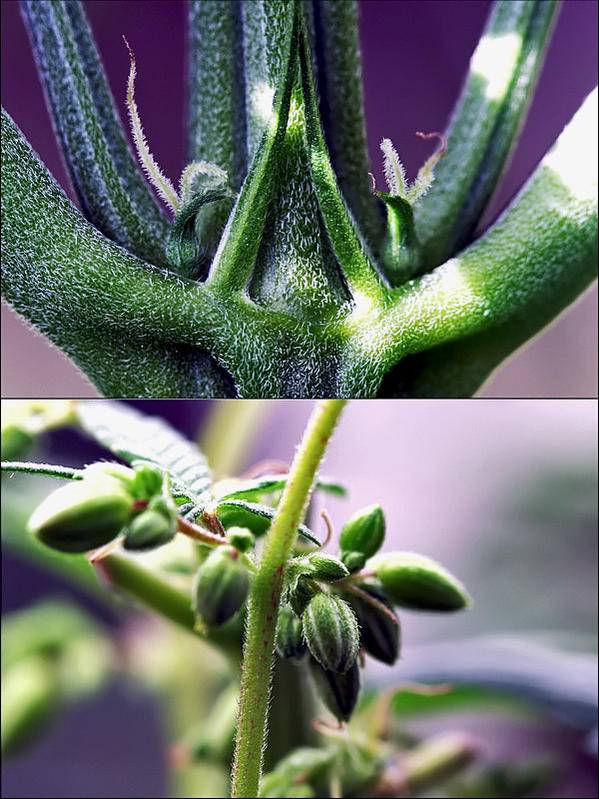
You might get around to cloning you females and clones can be started under 12/12 from the start since they are already mature so the transition into flowering is rather painless. Generally though, it's a good idea to wait until the clones gain some size before flowering them. It is good to keep in mind that although your plants will mainly concentrate on growing flowers, they will also direct some energy to vegetative growth during flowering as well, especially sativa dominant plants.
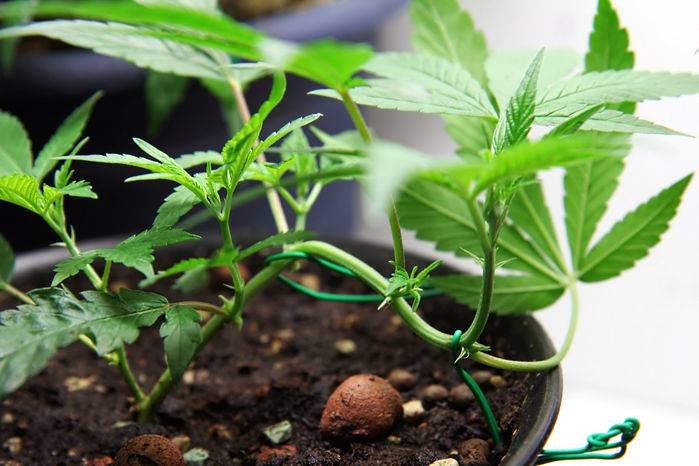
Topping, Training and Pruning
You might get around to cloning you females and clones can be started under 12/12 from the start since they are already mature so the transition into flowering is rather painless. Generally though, it's a good idea to wait until the clones gain some size before flowering them. It is good to keep in mind that although your plants will mainly concentrate on growing flowers, they will also direct some energy to vegetative growth during flowering as well, especially sativa dominant plants.
Keep in mind that plants will generally double or triple in height once you change the light schedule to 12/12, so some consideration should be placed on the time of flowering.

Topping, Training and Pruning
Please refer to my extended guide for more information on topping, training and pruning plants for an improved harvest.
The extended guide also contains detailed information on how plants work in case you want to find out more.
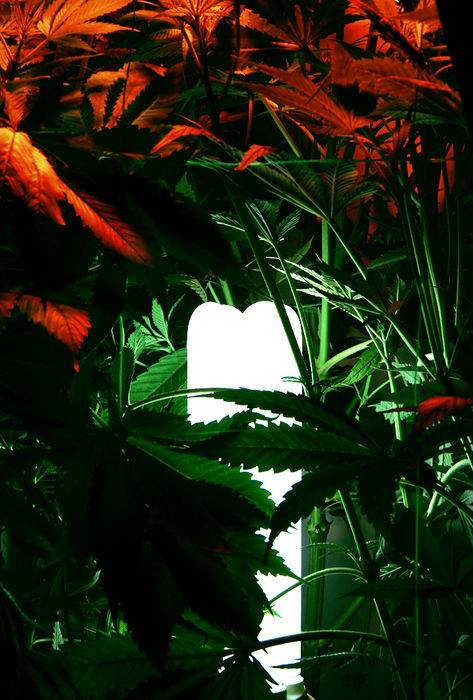
My Take on Different Light Schedules
I have grown cannabis under many different light schedules in many different combinations and here is my take on it. I’m leaving out combinations that did not differ much from the ones listed here. I have not considered problems with space in grow rooms here. Basically if you are running a small cab or pc case grow, grow Lowryders for best result.
Cannabis plants are capable of constant photosynthesis under 24h of light during the vegetative stage of development.
In the words of Ed Rosenthal:
"Cannabis under continuous light will grow 33% faster than the same plants on an 18-6 light regime."
In the words of Ed Rosenthal:
"Cannabis under continuous light will grow 33% faster than the same plants on an 18-6 light regime."
There seems to be some confusion when it comes to something called the dark reactions that take place in plants. They are called dark reactions because they are light-independent, but this does not mean that they only take place in darkness. As a matter of fact, the dark reactions occur regardless of the amount of light present as long as the proper substrate compounds are available. These compounds are created during photosynthesis which means that the dark reactions cannot function without light.
However, although cannabis plants are capable of photosynthesizing 24/7, they still need some darkness in order to maintain a proper hormonal balance. So apparently, by keeping your plants under a 24/0 light regime, you are actually inhibiting the circulation of growth hormones that the plant needs in order to stay healthy and eventually prepare for flowering among other things.
Everyone would not agree with me on this. I will not go further into this subject here, you can find more information regarding these mechanisms in the guide on topping, training and pruning, mentioned above. On to the different light schedules.
24/0 --> 12/12
After many grows I have noticed that running the lights 24/7 during the vegetative stage is of little use compared to 20/4 or 18/6. In nature the length of the day decreases gradually, not over night. I also think that constant light without a rest period is not beneficial for the seedlings, might put your equipment under unnecessary stress and run up your electric bill for no more than a 5-10% increase in weight, at the most. Some state that the equipment is actually placed under most stress when the lights go on, so perhaps it is not a valid argument here. You can make your own conclusion regarding this point. It can be said that this photoperiod is unnatural but then again, periods of close to 24h sunlight during summer days is not unheard of in arctic regions. On the other hand, how would you cope with around the clock work and no sleep? The dark period is important for the plant to build up and move around essential biological components, ultimately it affects the plant on almost every level. Still, many use it because it is easy and gives good results. In my opinion however, the transition into flowering from this light schedule also makes the stretch unnecessarily long due to the 12 hour difference in the photoperiod.
Hey! Where did the sun go?
20/4 --> 12/12
This is a kinder option for the plants, your equipment and your electric bill. This gives the plants some time to rest and your equipment time to cool down once and a while. Still, the 8 hour jump in the photoperiod after the switch to 12/12 is a bit of a stretch.
18/6 --> 12/12
This is a valid option to the light schedule above. Not that big a difference in final stretch as the stretch caused by increased dark hours during the vegetative stage evens out with the lesser stretch in early flowering stage after the 12/12 switch. The plant might be a bit stronger under this light schedule compared to the one above as it has some time to rest. 18/6 is nowhere near the equatorial daylight length that sativas are used to but is suitable for both indicas and sativas during the vegetative stage.
20/4 --> 18/6 or 16/8 --> 12/12
This is a good option, at least when growing from seeds. This light schedule gives the plants a chance to prepare for flowering in good time with minimal stress. You could run the lights 20/4 for about two weeks, then switch to 18/6 or alternatively 16/8 for another two weeks and finally 12/12 for the duration of the flowering stage (I usually drop the daylight hours to 11/13 in late flowering, this benefits especially sativas but works well for indicas too, don't go much lower though).
20/4 --> 18/6 --> 16/8 --> 14/10 -->12/12
The best option. Same as above but a little more work. Depending on the length of desired vegetative growth, decrease daylight by 2 hours say every 7 days or so until you reach 12/12 on the timer.
If you are going to take the time to grow weed, why not take the time to reprogram your timer?
12/12 from start
This one is good when flowering clones but can also be used on mostly or pure sativas as an alternative to 13/11. I always clone the strongest females and keep them in a constant vegetative stage in a separate grow room. Once my harvest is done, I take a clone of the mother plant and move it into the flowering room. Usually the mother plants have several months of vegetative growth as well as rigorous training under their belts, so these heavy duty bonsai plants are well established, strong and produce monster crops. Their stems are usually as thick as my thumb when they go into flowering.
That’s my take on it. I think that it’s pretty close to the truth, considering natural environments and chemical processes that take place in the plant under different stages of their life cycle. Some people also swear by unorthodox light schedules outside the natural ones but I cannot expand on this subject because I have not tried them myself.
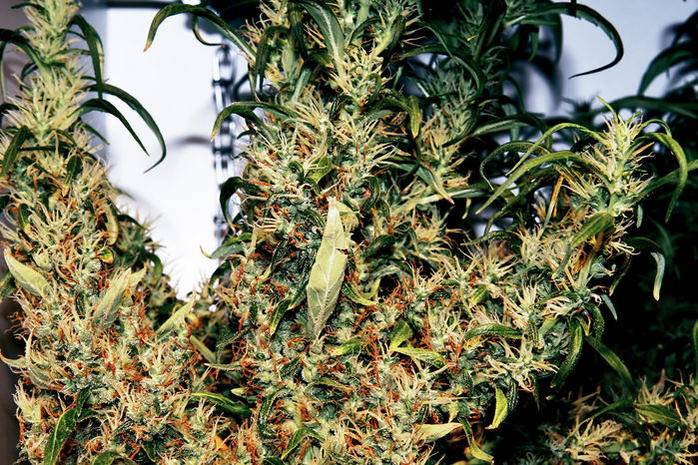
This is a good option, at least when growing from seeds. This light schedule gives the plants a chance to prepare for flowering in good time with minimal stress. You could run the lights 20/4 for about two weeks, then switch to 18/6 or alternatively 16/8 for another two weeks and finally 12/12 for the duration of the flowering stage (I usually drop the daylight hours to 11/13 in late flowering, this benefits especially sativas but works well for indicas too, don't go much lower though).
20/4 --> 18/6 --> 16/8 --> 14/10 -->12/12
The best option. Same as above but a little more work. Depending on the length of desired vegetative growth, decrease daylight by 2 hours say every 7 days or so until you reach 12/12 on the timer.
If you are going to take the time to grow weed, why not take the time to reprogram your timer?
12/12 from start
This one is good when flowering clones but can also be used on mostly or pure sativas as an alternative to 13/11. I always clone the strongest females and keep them in a constant vegetative stage in a separate grow room. Once my harvest is done, I take a clone of the mother plant and move it into the flowering room. Usually the mother plants have several months of vegetative growth as well as rigorous training under their belts, so these heavy duty bonsai plants are well established, strong and produce monster crops. Their stems are usually as thick as my thumb when they go into flowering.
That’s my take on it. I think that it’s pretty close to the truth, considering natural environments and chemical processes that take place in the plant under different stages of their life cycle. Some people also swear by unorthodox light schedules outside the natural ones but I cannot expand on this subject because I have not tried them myself.
Flowering
What we are talking about when referring to bud, are unfertilized female flowers, or sensimilla. As long as the female plant remains unfertilized, she will continue to flower and thereby also produce Delta-9-Tetrahydrocannabinol or THC, the main psychoactive substance found in the Cannabis plant. THC is an oily, resinous substance that is formed inside fine outgrowths or appendages called trichomes. Trichomes are most abundant on the floral clusters of the female plant, but can also be found on other parts. There are also other substances that fall under the category of cannabinoids, which are by definition compounds that are structurally related to THC.
Once the plant enters the flowering stage, it will produce this substance in abundance. The quality and quantity of the finished product varies according to strain and growing conditions.
The most important thing to remember during this stage is that absolutely no light may reach the plants during the dark hours as this will interfere with flowering and might even stress the plant into sex reversal. You need complete darkness in the grow room. I am talking pitch-black here.
Once the plant enters the flowering stage, it will produce this substance in abundance. The quality and quantity of the finished product varies according to strain and growing conditions.
The most important thing to remember during this stage is that absolutely no light may reach the plants during the dark hours as this will interfere with flowering and might even stress the plant into sex reversal. You need complete darkness in the grow room. I am talking pitch-black here.
The flowering time stated for a certain strain by the breeder is a general guideline and will seldom correlate with the exact flowering time in your own garden. Usually these flowering times reflect the time it takes for plants to mature under optimal conditions, like in large greenhouses, where the environment is precisely controlled. Trust your feelings, harvest the plant when it looks ready and forget about counting weeks. Most plants will take a few weeks longer than stated to mature properly in my experience. The flowering time can also vary depending on the phenotype of that particular strain. Genotype is the genetic makeup of an individual and phenotype is the physical expression of those genes. There might for example be a range of phenotypes that can be found among the seeds of an indica/sativa hybrid. All the different phenotypes might also have different flowering times.
The flowering time can range anywhere from 6 weeks for fast indicas to 20+ weeks for pure sativas.
Once the plants have begun flowering, you should also stop foliar feeding them. Never spray the flowers with water and always try to keep the relative humidity in the grow room as low as possible during flowering to minimize the chance of mold. Mold can take hold quite easily on the buds and once that happens, it might be difficult to get rid of without removing entire buds or even branches.
Patience always pays off in the end. The decision to harvest too early will always result in a smaller harvest and immature buds. Cannabis plants usually go through two to three bloom explosions during flowering, when the bud mass essentially doubles each time. The first bloom explosion can be expected after about 4 weeks of flowering, the second at 8 weeks and so on depending on the strain and the individual plant. Trust your feelings. Harvest the plant when it is ready.
Sometimes you have to wait a long time. Patience is a virtue when it comes to growing weed. For a speedy harvest, I recommend that you grow mostly indica plants.
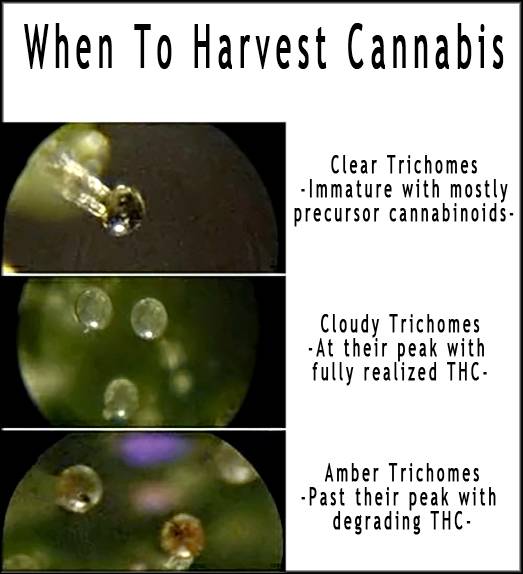
There are three types of trichomes that can be found on cannabis plants but the one that we want in abundance is the capitate-stalked glandular trichome that looks like a mushroom, because it also contains the highest levels of THC. The peak of THC production is when most of the oil inside the trichomes has turned from clear to cloudy, with a few amber ones here and there. Clear trichomes contain mostly precursor compounds and immature THC but cloudy ones are at their peak. Amber-colored trichomes have already passed the peak of THC production and contain mostly lesser and nonpsychoactive cannabinoids.
The amount and dominant type of trichomes on any given cannabis plant is partly genetic but the formation of resin glands and the process that takes place inside them, is also heavily dependent on the sum of all the environmental factors involved. Providing good growing conditions goes a long way, so I think it's always wise to give the plant the best possible start.
There are at least 80 known cannabinoids that can be found in the cannabis plant. Read more about trichomes and cannabinoids here and more in-depth here
All the cannabinoids start out as carboxylic acids (THCA, CBDA etc.)
The synthetization of Delta-9-Tetrahydrocannabinol inside the trichome goes as following:

The final Cannabinoid production starts with formation of cannabigerolic acid (CBGA). From here it is independently processed into either:
There are at least 80 known cannabinoids that can be found in the cannabis plant. Read more about trichomes and cannabinoids here and more in-depth here
All the cannabinoids start out as carboxylic acids (THCA, CBDA etc.)
The synthetization of Delta-9-Tetrahydrocannabinol inside the trichome goes as following:
The final Cannabinoid production starts with formation of cannabigerolic acid (CBGA). From here it is independently processed into either:
1. CBC (cannabichromene), nonpsychoactive compound.
2. CBD (cannabidiol), although it is generally considered nonpsychoactive, it affects how the THC hits us. CBD also has some therapeutic properties, making a high CDB value good for medicinal strains.
3. THC (delta-9-tetrahydrocannabinol), brings on the narcotic stone and cerebral high that sometimes border on the psychedelic. A very high THC content can also increase your pulse and cause paranoia. Some of the THC will always be in acid form. THCA turn into THC over time when the bud is cured or when it's heated to certain temperatures.
4. CBN, once the bud is harvested, THC starts degrading into CBN (cannabinol). This also means that the THC on buds sitting in a jar will eventually degrade into CBN and other lesser cannabinoids. It might taste great and smooth but it's probably less potent than at the time it was harvested. This is why we store the buds in air-tight jars and in darkness because we hope to reduce the rate of THC degradation. Unlike THC, CBN is nonpsychoactive and mainly causes disorientation and "fuzzy head", both of which can be quite unpleasant in nature.
There are also several other cannabinoids that can be found in the plant (including cannabigerol or CBG and tetrahydrocannabivarin or THCV). Some tone down the high, while others enhance it. The cannabinoid profile can vary greatly from strain to strain but for the most part we find either THC, CBD or both. Some of the non-psychoactive cannabinoids have therapeutic properties, which makes them suitable for medicinal use.
The rate and quality of the synthesized THC is naturally dependent on the availability of nutrients and environmental conditions. High intensity of light and aridity during flowering is generally considered two factors that promote resin production.
Note the trichomes in this picture. They look like crystal mushrooms but are actually spherical containers for the THC oil. Keep in mind that every time you touch a bud you are breaking these fragile structures and THC evaporates into the air, which is why I try not to touch the buds unnecessarily during flowering. On the other hand, there is enough to go around so don't worry about it too much. In order to know for certain at what stage of development the oil inside the trichomes is, you will have to buy some kind of magnification glass or loupe that enables you look at closely at these appendages.
Besides looking at the trichomes through magnification there is another way to tell if the harvest is ready.
When 50% of the visible hairs on the bud have turned brown, it is generally considered ready although this is a very rough indicator.
Here are some pictures describing the various stages of floral development, which might also help you decide when to harvest.
Observe how the calyx starts swelling up as the bud matures. This is the real indicator of mature bud.
You can clearly see this happen in late flowering, it looks almost as if the calyx was bearing seed because it increases dramatically in size.
The timing of the harvest can greatly affect the quality of the finished product. Although it is not this simple, it can be said that if you harvest too early the high will be disappointing, incomplete and mostly in the body while harvesting at the right time will give you a well rounded, potent and profound experience. You have to give the plant some time to develop fully realized THC. The best time for the harvest varies from strain to strain and from individual to individual. You will have to keep a close eye on the plant during flowering. It is not as difficult as it sounds, when you see thick and heavy buds packed with trichomes, you know that it is close to harvest time.
You will always have bud that is in different stages of maturity as the plant keeps flowering and forms new buds all the time. New flowers actually grow on top of old ones, so you get a layer of bud. This also means that you have trichomes all over the plant that are in different stages of development. Just make sure that the bulk of the crop is ready before harvesting. Or just harvest the top half of the plant and leave the bottom half flowering for another month or so. Those popcorn buds will eventually pack on weight, but personally I do not think that it's worth the wait.
Pure sativas can carry a racy, stratospheric and sometimes creative cerebral high, so strong that you'll be blown into next dimension. Indicas on the other hand can pack a strong narcotic stone so numbing that you lose the ability to speak, let alone think. That's why they are good pain killers. Indicas also contain slightly higher concentrations of the therapeutic cannabinoid CBD, especially landrace indicas. Cannabis Ruderalis contains almost no THC and has mainly been used to make industrial hemp and auto-flowering hybrids like the Lowryder. Lowryders are considered good medicinal strains since Ruderalis contains large amounts of CBD and it carries over to the new crosses, along with moderate levels of THC.
THC is quite a complex compound that binds to several cannabinoid receptors found in the brain and other parts of the body. The high varies depending on the presence and amount of the various cannabinoids, which all work in combination with each other to provide the experience. THC also accumulates in the fatty tissue of the body. This means that the more cannabis you smoke, the longer you have to wait in order for it to leave your system. This is important to remember if you are periodically subjected to drug testing.
THC has many uses for the plant, including fighting off pests, prevention of desiccation and to some degree keep the buds dry due to the fact that THC oils are hydrophobic and reject water. Cannabis plants can actually kill insects because they get stuck in the sticky resin. Once stuck they die and start to slowly dissolve. Death by THC. Several studies on marijuana optics have shown that the plant forms trichomes as a defensive strategy against ultra-violet radiation. The glandular resin heads bind solar energy so that it will not harm the growing tissue or cause mutations in the plant.
I'm sure that many will agree that bud grown under the sun will most of the time blow indoor bud out of the water in terms of potency. No matter how you twist it, I bet that cannabis grown on the top of the Himalayas will always be more potent than indoor bud. The incredible power of the sun cannot be matched by man-made instruments. Sticky and Heavy Bud. Taste and smell however can be more refined in indoor bud as we can control what we feed them. Outdoor bud usually has a feral taste to it. Not that it's unpleasant, not at all, the wind and the rain all leave their mark on the buds and you can really taste the difference. Don't get me wrong though, indoor bud can still be extremely potent. The fact is that THC is a strong (although relatively harmless) substance that can have a profound effect on the casual smoker, even in small doses. On the other hand, THC also accumulates in the body, which means that you grow more resistant to the effect. That in turns means that the longer you smoke, the more you have to burn in order to get high.
Like I mentioned before, the buds might get so heavy that you will have to provide addition support for them, especially if you do not use fans to strengthen the stem. This can be done by either using string, gardening wire or a SCROG net. By Scrogging (Screen of Green) I am referring to the style of growing where you have your plants growing through a net that is suspended above the canopy. The goal is to fill the entire surface area of the net with budding flowers in order to maximize the crop. If you would like to know more, have a look at the guide on topping, training and pruning.
One thing that is of major concern when it comes to the flowering stage is the stretch that plants go through when the light regime is changed to 12/12. If the difference between the vegetative and flowering light regime is great, the plants will also stretch more. The natural response for the plant is to start reaching for the light. It is therefore more natural for the plant to be gradually introduced to the flowering light regime by shorting the length of the day in the manner explained in the section above.
Another thing that reduces the stretch is keeping the blue light present during the first week of 12/12. Personally I leave the metal halide bulb in for this period of time before switching to the high pressure sodium bulb. The same applies to compact fluoros of corresponding spectrum.
It can be debated whether or not plants increase resin production under stress. Personally I try not to stress them too much as there is a difference between stress and torture. I have found that keeping a dry environment in combination with high intensity of light will promote resin production. When you think about it, it makes sense. The loss of water is of great concern to most plants so the cannabis plant tries to protect itself against the strong light and heat by forming more trichomes.
I believe that providing the optimal environment for the plants will ensure that they express their true potential without the need to stress the plant beyond a certain point. Healthy plants will have greater potential than plants that are in a state of deficit.
Treat them well and they will reward you.
You might also want to keep records of the plants that you grow. Here is an example of how you could keep track of different strains.
Page 1 - Page 2 - Page 3 - Page 4 - Page 5
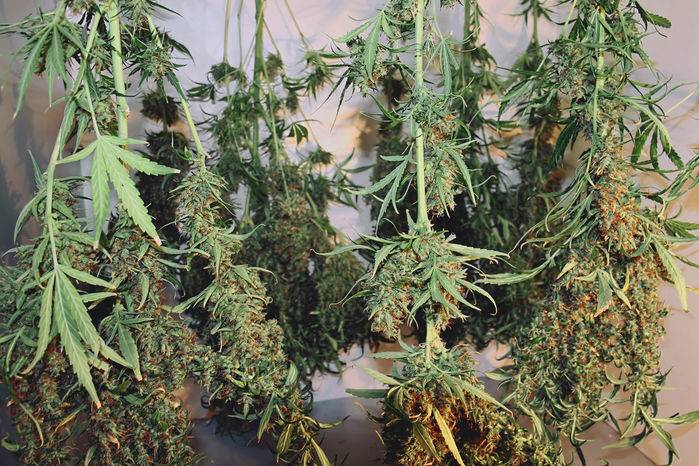
Drying, Curing and Storing
No big secret here, just dry the buds first slowly by air and then allow them to cure in mason jars or something similar. The remaining THC-acid (THCA) will turn into fully realized THC during this time. The taste and smell of the bud will also improve with time like fine wine, just make sure that the containers are air-tight and stored in a dark place as both light and air will speed up the THC degradation process. Over time the THC will degrade into CBN no matter what so you might get a smooth smoke but the bud will not be as potent as the day you harvested the plant.
It is not advisable to quick-dry and smoke freshly cut buds because they will not taste good or pack the potency that you expect. If you have made it this far, you must have a little bit more patience. You will be greatly awarded.
Start by cutting down the plants and hanging them upside down in a cool, dry and dark place. Do not allow the humidity to rise at this point or your entire harvest might be lost to mold. Fresh air must be allowed to pass around the buds so that they will dry properly. You can have a fan blowing over the buds for this reason. If you decide to remove the buds from the stems right after harvest, make sure that you turn them around every now and then so that all sides will have chance to dry properly. You will know when the buds are dry because the stems attached to them will snap like twigs and the bud will be brittle and easily crushed under your fingers. It will take upward of a week for the buds to become dry, after which you can move them to the jars for slow curing. The longer you keep the buds in the jar, the better they will taste and smell. THC will also mature during this time, turning your buds into the potent smoke that you were hoping for. A few months inside the jars will really work wonders on the smell and taste but the bud can be smoked at any time after it is dry.
When you have harvested the buds you will probably want to manicure them by removing excess leaf matter as this will give the buds more "bag appeal". It won't change the finished product but makes the buds more pleasing to the eye. Usually when you do this you end up with sticky resin on your fingers and the scissors you are using. Collect this black tar and roll it up in a ball, this is called charas or finger-hash. A very small amount of this stuff is enough to send you into orbit as it is almost pure THC.
Cannabis be turned into hashish by collecting the trichomes (kief) with a kiefing screen or sieve and then pressed together into a solid form. The holes in the screen have to be small enough to only let the trichomes pass through. The kief can also be smoked as it is but it is easier to handle and store when pressed into one solid brick or ball. There are several methods of collecting kief and turning it into hash, so look up a thread if you need more information on the subject.
One thing that many overlook is that if you store your buds in a plastic bag, a lot of the trichomes will fall off over time and accumulate in the bottom of the bag. If you place the bag in the freezer for a day, you can easily scrape off the kief with a knife and then smoke it. If you store your buds in a jar, add some water to it when it is empty and shake it for a few minutes. Finally sieve the solution through a coffee filter and you will also end up with some kief.
Cannabis can be used in cooking to make everything from "cannabutter" to "space cakes" or whatever one chooses. THC is hydrophobic but soluble in fat. There are detailed posts here on the forum on how to cook with cannabis. The easiest method however is to heat some bud in water on low heat with some real butter. After some time when you feel that most of the THC has bounded with the fat, sieve the liquid into another container in order to remove the plant material. Then allow it to solidify in the fridge or freezer. Once solid, the "cannabutter" cake can be removed and used in cooking. There are other methods for extracting THC from plant material but turning it into butter is the easiest way.
Keep in mind though that enough heat will make the cannabinoids evaporate:
THC has a boiling point of 200°C (392°F). However before the THC boils, other parts of the oil evaporate and boil.
Here are some important temperatures:
At 21°C (70°F) - the most volatile terpenoids start to evaporate, lending a pungent odor to the air.
At 31°C (87°F) - the less volatile terpenoids start to evaporate, lending the air even more pungent odors.
At 39°C (102°F ) - virtually all of the terpenoids undergo evaporation fairly rapidly.
At 122°C (252°F) - Most of the THC-Acid decarboxylates as the water molecule held in the carbonate form evaporates. This activates the THC.
At 185°C (365°F) - Cannabinol (CBN) boils.
At 190°C (374°F) - Cannabidiol (CBD) boils.
At 200°C (392°F) - THC boils. Clear vapor from a vaporizer.
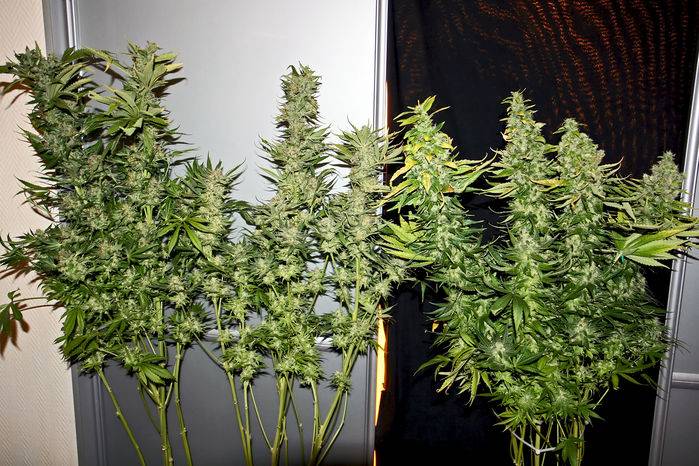
Here are some important temperatures:
At 21°C (70°F) - the most volatile terpenoids start to evaporate, lending a pungent odor to the air.
At 31°C (87°F) - the less volatile terpenoids start to evaporate, lending the air even more pungent odors.
At 39°C (102°F ) - virtually all of the terpenoids undergo evaporation fairly rapidly.
At 122°C (252°F) - Most of the THC-Acid decarboxylates as the water molecule held in the carbonate form evaporates. This activates the THC.
At 185°C (365°F) - Cannabinol (CBN) boils.
At 190°C (374°F) - Cannabidiol (CBD) boils.
At 200°C (392°F) - THC boils. Clear vapor from a vaporizer.
Some of the THC will always be in acid form (THCA - Look at the THC synthetization chart). Here is a chart that shows the rate of decarboxylation of THC-Acid into fully realized THC at different temperatures. It might come in handy when you are cooking with cannabis.

The Overlooked Secret to a Bountiful Harvest
One of the easiest ways of improving on plant health and maximizing plant potential is in my opinion the use of the symbiotic root fungi or mycorrhiza in the soil. This fungus has had a mutualistic relationship with plants for over 400 million years, 92% of plant families and 80% of all known plant species form this relationship in the wild.
The fungus connects to the plant roots effectively increasing the root surface area and therefore nutrient uptake considerably. It also functions as a skilled mediator between plant and soil, buffering out nutrient problems and improving on plant resistance. You can buy spores of this stuff in more advanced grow or garden shops or order it online.
Here we have an example of a plant that has formed a symbiosis with the root fungus. You can see how the thin white microfilaments of the fungus radiates from all the roots. Mycorrhizal mycelia are much smaller in diameter than the smallest root and can explore a greater volume of soil, providing a larger surface area for absorption, thus improving the nutrient absorption capabilities of the plant roots.
Studies have shown that mycorrhizal root systems increase the absorptive area of roots 10 to 1000 times thereby greatly improving the ability of the plants to utilize the soil resources. In the great outdoors this relationship is always present in the plants that can form it in the first place. Usually the strain of mycorrhiza is restricted to a certain species of plant but the good news is that because cannabis is a weed, it can form this relationship with a wide range of mycorrhiza species. More proof of how this amazing plant is superior to many other.
Read more on symbiotic mycorrhizal fungi here
Cloning
Cloning a plant means that you take a cutting from a larger plant and persuade that cutting to form roots. This is possible because any part of the plant is capable of producing roots.
The most common method is to cut one of the smaller branches from the lower part of the plant and put in some sort of rooting medium. There are several methods for cloning plants, which include water cloning, straight to soil or using rock wool cubes. Personally I use a cloning bubbler which is essentially a small hydroponic setup with a container, an aquarium air pump, a hose and an air-stone. I then suspend the cuttings in the water while the pump provides oxygen for the newly cut clones as that is the most important component for the formation of new roots.
This method is so successful that I pull clone after healthy clone out of this contraption. I cannot think of a better way to do it, most clones root within a week or two. This is good because until the plant roots it will have to survive on the energy stored in its leafs.
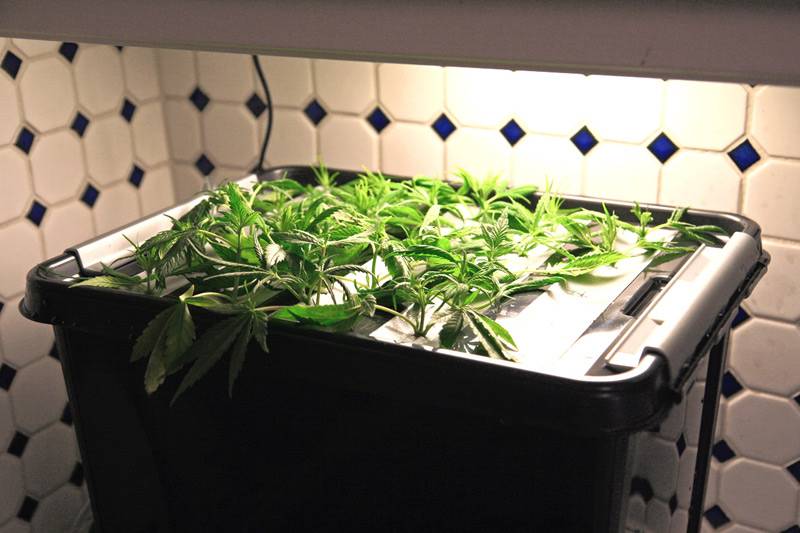
Click the link if you want to know how to build the Propagation Bubbler
It is a good idea to dip the cuttings in a rooting hormone like clonex before planting them in soil or rock wool cubes. Adding general plant hormones like auxin found in seaweed extract will also speed up the process.
Click the link if you want to know how to build the Propagation Bubbler
It is a good idea to dip the cuttings in a rooting hormone like clonex before planting them in soil or rock wool cubes. Adding general plant hormones like auxin found in seaweed extract will also speed up the process.
The reason why cannabis plants can be cloned is because they are capable of forming so called “adventitious roots” on any tissue. This is also why we see new roots growing on the stem in humid environments. If you intend to repot you plants at some stage, always plant them a bit deeper than before because new roots will form on the sections of the stem that become covered by soil.
It is also possible to clone plants in flowering but I have found that it is very rarely that it succeeds, so always make sure that you have clones of each plant that you are going to flower if you intend to keep mother plants. Once the plant has switched to flowering mode , it is very reluctant to revert to the vegetative stage. Take your clones as soon as you can and take lots of them as you never know how the cuttings will behave, some root faster and others take a long time.
Clones and mother plants do not need very strong light as the purpose is merely to keep them alive and not have them grow to monstrous proportions. A low wattage CFL will do the job. Trimming both the green matter and roots might become necessary at one point or another.
If you need more information on cloning, have a look at the official cloning thread by JJScorpio.
Most cannabis mother plants can be kept alive for a very long time. Once the mother plant loses vigor you take a new clone and start over. Cloning is the reason why there are so many commercial crosses out there made with the legendary G-13 mother. Here I would like to point out that no G-13 father was ever obtained so there cannot be any pure G-13 seeds out there unless the plant was selfed into feminized form. Most of the time we are looking at G-13 crosses.
Finally a very important note. Be very careful if you accept clones from friends. Although the gesture is noble, sometimes they can carry pests and often you will have to completely disinfect your grow room to get rid of them. And by disinfection I’m talking laboratory procedures here like boiling the loose equipment like pots in water, heating the soil in the oven in order to kill harmful insects and so on.
Plant hormones
There are three main types of plant growth hormones; auxin, cytokinin and gibberellic acid. These regulate the way that plants grow by affecting the rate of cell division, cell elongation etc. Kelp or seaweed extract is an outstanding source of plant hormones. Seaweed and algae have no roots and are either free-floating or merely anchored to the sea floor. Sea creatures constantly nibble on them which means that they need to rapidly grow more mass all the time so they never cease to produce these hormones. Cannabis plants can easily extract these plant hormones from water. The hormones make them stronger and improve on everything from root development in clones to vegetative and flower growth in mature individuals.
Basically it’s like putting your plants on steroids.
Please note however that plant hormones can also interfere with sexual development to some degree. Using too much of it might trigger hermaphroditism more easily in plants that are genetically prone to the condition. Heavy use of gibberellic acid has been known to trigger hermaphroditism in cannabis plants, so use the stuff wisely.
Hermaphroditism and Feminized Seeds
The term "hermaphrodite" derives from Hermaphroditus, the son of Hermes and Aphrodite in Greek mythology, who was fused with a nymph, Salmacis, resulting in one individual possessing physical traits of both sexes.
Hermaphroditism is a natural trait that occurs spontaneously in cannabis plants in the wild as an emergency response to the absence of either sex in a colony. As a matter of fact most dioecious plants have apparently evolved from hermaphroditic ancestors, so the trait remains partly active in many species of plants. Many tropical sativas are known to pop a few bananas late in flowering. It is more common that female plants produce staminate parts than vice versa, although both have been reported by growers. Male plants that are flowered for an unnaturally long period of time indoors have been known to produce female flowers.
Although hermaphroditism is a naturally occurring phenomenon that sometimes favors cannabis in the wild, normal dioecious individuals can also display this trait in unfavorable environmental conditions. Some even say that there are no true females because most female cannabis plants can be persuaded into sex-reversal by various degrees of stress. The most stable female plants will however not turn hermaphrodite no matter how much stress you subject them to.
Some examples of things that might affect the sex of your female plants are high temperatures, ph fluctuations, light leaks, water related stress and over fertilization. Female plants will most likely turn if they are genetically prone to this condition. The pollen from these hermaphroditic females can either be fertile or sterile. Once turned, the females will form modified or incomplete pollen sacks that look like bananas which are sometimes quite hard to notice. If the pollen is fertile it usually ends up pollinating all the plants in the grow room, effectively ruining the entire sensimilla crop.
Generally speaking, hermaphroditism is considered an unwanted trait in drug strain cannabis plants. The trait is dominant, which means that any parent carrying this trait will pass it on to its offspring. Normal and stable individuals are preferable to these plants that revert to a dual-sex state under stress. The females that are prone to this dual-sex condition are usually removed from the grow room as their offspring will also become hermaphrodites as easily as the mother did due to the fact that the trait is dominant. There are however some uses for this trait, which include making feminized seeds which contain only female genes and therefore result in only female offspring. It is good to keep this in mind when deciding whether or not to grow out your own seeds from a female pollinated by another female. If the hermaphroditic female turned easily from stress, you will also have trouble with hermies when growing out the offspring.
The reason why these seeds exist in the first place is that they remove the need to sex plants before flowering which saves growers a lot of time and trouble. The problem when it comes to feminized seed is that in order to create them, one hermaphroditic female has to pollinate another female or itself in order for the offspring to carry only female genes. The former would probably give better results because there would be recombination of the genes from both the female parents, while self-pollination is basically inbreeding, which gives rise to genetic depression and all sorts of physical disorders. Naturally the normal female would have to be stress-tested as well and proven stable for good results.
So in order to make good feminized seeds we have to stress out a lot of plants by manipulating the environment in order to find the plant that is most resistant to this condition, while still prone to it. Like I mentioned before, what can be considered stable females will most likely not take on this dual-sex state, even when they are subjected to extreme stress. It is therefore always a good idea to stress-test your plants in order to find out if they are easily prone to the hermaphroditic condition or not, so that the easily stressed hermaphrodites can be removed from the grow.
Only the most stable and tolerant plants will be suitable for making feminized seeds and these can only be found by putting the plants under a great deal of stress. In both cases the offspring will carry 100% female genes but the seeds from the easily stressed female will not be viable for growing, let alone cloning or breeding, as most of the offspring will have a tendency to revert to a dual-sex condition even under minimal stress. Once we have found a strong female candidate, we can start making feminized seeds. Usually silver water is administered to the stable females, which causes them to produce male flowers. I guess you could say that the stress from the colloidal silver is just too much for the female to handle and it reverts to a dual-sex condition as a natural response.
There is also another method called Rhodelization, which was developed by Soma. Rhodelization means that you allow a female plant to flower for an unusually long period of time, after which it develops a few male flowers as a last attempt to pass on its genes. This method is substantially slower but provides a natural way of producing feminized seeds without subjecting the plants to the extreme levels of stress that comes with the silver water.
High quality commercial seeds from feminized plants should therefore give rise to mostly normal females which are resistant to the hermaphroditic condition. This is at least what we can hope for but since nothing is 100% certain and different breeders have different standards, we might end up with hermies nonetheless. In any case, it certain that regular seeds will always have a genetic advantage over the feminized ones.
Pests
There are several different pests that attack cannabis. They range from the most harmful spider mites (The Borg) to the relatively harmless fungus gnats. Some of these pests are really nasty and can wipe out your entire grow. The fungus gnats are so common and harmless that I rarely bother to wipe them out unless their numbers grow high. If you encounter something more threatening, the only way to go is to disinfect your grow room. The most secure way is to scratch the grow and replace the soil as well as every pot you used. If you chose to disinfect the plants you need to use neem oil or pyrethroids (synthetic neuro-toxins) in order to get rid of the pest or some sort of homemade pesticide.
This recipe works great on most pests:
Soak a pack of strong cigarettes in water over night. Then boil some water with strong chili peppers in it (I’m talking high on the scoville scale here). Once it cools down, add the nicotine water to it, then some cooking oil and soap. The idea behind this is that the nicotine will poison the bugs and the capsicum from the peppers will burn them. Insects breathe through holes in their bodies called tracheae, so the soap and the oil will clog these holes and the insect will also choke to death on top of everything else. I used chili strong enough to burn my hands and the gnats were killed instantly dropping down in mid-air. It also worked on aphids and seems to deter spider mites as well. You can add alcohol and cinnamon to boost the effect, as most insects will not like it. Be careful when spraying this homemade pesticide directly on the plants as it is very strong and can possibly harm the plants as well. Dilute the solution if needed. I used it on the topsoil and the pesticide was strong enough to deter the insects from emerging, which lead to their death as they could not feed on the plant. Also, keep in mind that some of the ingredients of the homemade pesticide, like nicotine, are highly toxic to us humans as well. Use it with caution.
There are a couple of more things that you can do in order to free your plants from the burden of pests. You can sterilize the soil in the oven before you use it, in order to make sure that you kill everything. It is important not to let the temperature get too high when doing this because that causes toxicity in the soil, which might harm your plants. Look it up on the web if you need instructions.
If the infestation has spread to the plant itself, use several different pesticides at once for best results. The home made remedy works quite well but there are other alternatives, like pyrethroids (synthetic neurotoxins) and neem oil. If the plants are in veg, you can wash them repeatedly with water in the shower, which actually works pretty well if you are thorough. Even on spider mites and eggs, they just wash away and disappear down the drain.
One last solution is to submerge the infected pots under water. After some time you start to see critters abandoning ship and heading to the surface for air. Plant roots can survive for some time without oxygen, at least longer than the pest you are trying to get rid of, so this method is both easy and safe.
Breeding
From every seed the promise of new life.
No plant is the same, they all have a different genetic makeup. The only exception are clones. Since they are in every way the same plant as the mother, their genetic makeup is also identical. That is why you need to clone plants that prove to be superior or if they have qualities or traits that you like. This way you can preserve and grow the same crop over and over. Cannabis is not the easiest plant to clone but not the most difficult either. The chance of successfully cloning a plant depends on the strain, the methods used and so on.
Genotype is the genetic makeup of an individual and phenotype is the physical expression of those genes.
When it comes to breeding we get genetic recombination of the genes, 50% from the father and 50% from the mother. Since the genetic makeup of plants is so complex there really is no way to predict which of the original traits will be preserved in the offspring and how new ones will form. The only thing that can be said is that the offspring will show similar traits to the parental strain but this is heavily dependent on whether or not a particular trait is dominant or recessive.
Some traits are dormant or inactive and will only be activated if the alleles for that particular trait correspond in the genes of both parents. This means that the offspring will display some/none/all of the traits of the parents but new ones will also form depending on the genetic recombination.
The F1 or first generation of plants will be quite uniform in appearance but once you reach the F2-generation, you will get individuals with a wide range of traits inherited from the parents. In order to get uniform plants that resemble the parent, you need to isolate traits by backcrossing the offspring to one of the parental plants. This is effectively inbreeding which is naturally unfavorable as genetic anomalies may occur because the same genes perform the recombination and the gene pool is restricted. This method, referred to as “cubing”, is sometimes used to preserve a particular trait and will result in uniform or true breeding IBL (inbred) seed lines. Crossing the plant to a new one will however produce very healthy offspring because the gene pool is expanding and the genetic recombination gives rise to hybrid vigor. Plants will also become uniform over time through selective breeding. This is the case with Skunk#1 for example. Large populations are used to interbreed the individuals and because they resemble each other so much, the offspring is also quite similar to the parents.
In other cases, careful selection is required. I’ll take the example of how the Lowryder#2 strain was created to prove my point here.
The goal is to preserve the recessive auto-flowering trait:
a = recessive auto-flowering trait
A = dominant normal flowering
Lowryder was bred to Santa Maria/Planck in order to create LR#2. So;
The goal is to preserve the recessive auto-flowering trait:
a = recessive auto-flowering trait
A = dominant normal flowering
Lowryder was bred to Santa Maria/Planck in order to create LR#2. So;
Santa Maria x Lowryder = AA x aa = 100% Aa F1 --> The auto-flowering trait is masked by the gene for normal flowering but all the offspring carry the recessive trait.
(Santa Maria x Lowryder) x Lowryder = Aa F1 x aa = 50% Aa F2 + 50% aa F2 --> 50% auto-flowering in the second generation. This is where the selection for AF plants begins. We pick one of the AF F2's and cross it once more to a true breeding Lowryder,
[(Santa Maria x Lowryder) x Lowryder] x Lowryder = aa F2 x aa = 100% aa F3 = Lowryder#2
As you can see, if we take one of the auto-flowering F2-individuals and cross it to a true breeding Lowryder we get the same result as when we cross two true breeding Lowryders to each other (LR x LR), 100% auto-flowering individuals.
So, if you want to make a new auto-flowering Lowryder hybrid, you have to backcross it twice to true breeding Lowryders in order to preserve the auto-flowering trait in the new hybrid. Remember though that this F3-offspring only carries 12,5% of the genes from the non-auto-flowering parent. In order to increase this percentage you have to start the process all over again.
Some traits might be controlled by several genes which means that the odds are even smaller that this particular trait will be expressed, especially if it is recessive.
The same goes for every trait of the plant, everything from potency to color so my recommendation is to only use the strongest plants you can find for breeding purposes.
The same goes for every trait of the plant, everything from potency to color so my recommendation is to only use the strongest plants you can find for breeding purposes.
If you are planning on making your own hybrids, it's not a bad idea to read up a bit on Mendelian Genetics
The actual act of fertilization is no big mystery. I will not go into it in great detail here but one male carries enough pollen to pollinate a whole bunch of females. Once mature, the pollen sacks spring open, dispersing the pollen. It looks like fine yellow powder. The pollen can be collected, dehydrated and stored for up to six months in the freezer, after which it is usually no longer viable. Seeds on the other hand can be stored for decades as long as they remain in a cool, dark and dry environment. Seeds as old as 30 years have reportedly germinated.
The best way go is to allow one male to pollinate all the females chosen for the breeding project. If you have several males of different strains, you will have no idea which male pollinated which female. You can have several males of the same strain pollinating the females, but I usually chose the strongest male for the job. There are two schools of reasoning here. On one hand you could say that the strongest male will always be the best candidate but on the other hand you might also reason that using several males will in fact increase the gene pool and possibly give rise to a wider array of traits in the offspring. This might be beneficial if you need to find good outdoor plants, some will adapt better than others to harsh conditions.
What we really want is to preserve the traits of the mother plant, but we also need the father in order to make seeds. The father contributes to an assortment of traits in the female offspring, including physical appearance, flower formation and structure as well as scent and taste. You need to decide what to look for when choosing the parents, what traits you consider desirable. You should also look for males that form tightly packed clusters of male flowers as this directly affects the structure of the bud in female offspring.
The criteria for selection naturally varies with the purpose of the plant. When you are breeding outdoor strains you might look for different things than when you breeding indoor strains. It is not a bad idea to make a list of the traits that you looking for, as this will help you decide which males and females to keep. Smoking both parents is also essential since you need to get an idea of their potency. Some males and females carry more THC than others and smoking them is the only way to find out what you have.
In order for the pollen to be spread around you can have a fan blowing over the plants or you could just blow on the male plant now and then, this is enough for the pollen to reach the females if they are in close proximity. Another good way to pollinate the female is to use a brush. Gather the pollen onto the brush and then transfer it to the females. Once the females have been pollinated, it takes about 6 weeks for the seeds to be ready. You will know when they are ready because the calyx opens up and the seed falls to the ground. Once you see that a few seeds are ready you can harvest the whole plant shortly after. It’s a lot easier to separate the seeds from the bud if you allow them to completely dry up first.
One way of telling if the seeds are ready is to look at the color and texture of the seeds. If they have a nice dark brown color with stripes on them, they are ready. Not all seeds are striped however but most are. Seeds can range in size from very small to quite large. Seed size is both genetically determined but also by the degree of pollination. A slightly pollinated female will generally produce a smaller amount of large seeds while a heavy pollinated one will produce lots of smaller seeds. The rule of quality vs. quantity applies here.
You will get hundreds if not thousands of seeds from one female plant.
That concludes the guide. Just one more thing.
That concludes the guide. Just one more thing.
The most important advice of all; remember to have fun growing your plants
The guide is also now available for download in pdf format

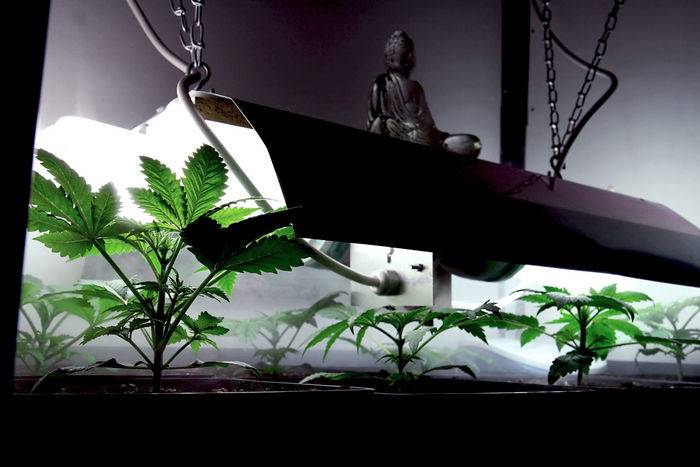
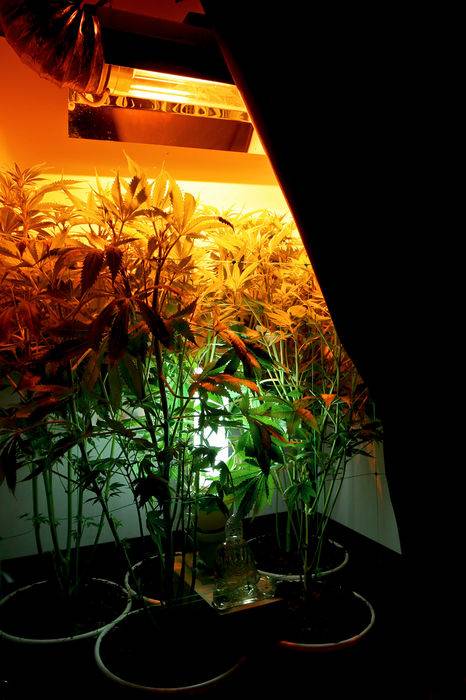
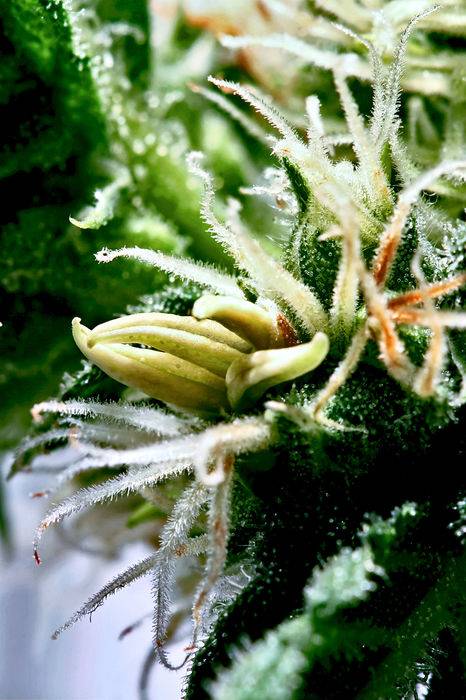



 kind regards from guineapig
kind regards from guineapig 
